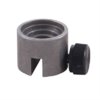Linko
Silver $$ Contributor
I am learning from what I read on our posts. I have started late in life reloading so I am on a kind of crash course. Been at it now 2 years. long range is the main goal but I also am loading some Hornet and AR rounds.
I have read how some bullets are sensitive to seating depth some not so much. But all need to be set to some figure relative to the lands. So I am working on measuring the CBTO dimension vs the touching measurement from my stoney point measurements.
I have variance between the same bullets and the same setting on my whidden seating die (6BR).
I understand bullets from the same lot have a spread of measured base to ojive. hence the variance in seated measurements loaded. Think I have that right.
So is it correct to say seating depth is a range and after seating and measuring some additional adjustments of the seating depth would be necessary to get the same seating depth. or close to the same?
As for tools to measure since the ojive on every bullet type is different no one tool is going to have the perfect dimension to get measurements consistantly. correct? I am using the Hornady tool on a Caliper for my measurements.
The process is not exact round to round. I am close on my understanding?
I have read how some bullets are sensitive to seating depth some not so much. But all need to be set to some figure relative to the lands. So I am working on measuring the CBTO dimension vs the touching measurement from my stoney point measurements.
I have variance between the same bullets and the same setting on my whidden seating die (6BR).
I understand bullets from the same lot have a spread of measured base to ojive. hence the variance in seated measurements loaded. Think I have that right.
So is it correct to say seating depth is a range and after seating and measuring some additional adjustments of the seating depth would be necessary to get the same seating depth. or close to the same?
As for tools to measure since the ojive on every bullet type is different no one tool is going to have the perfect dimension to get measurements consistantly. correct? I am using the Hornady tool on a Caliper for my measurements.
The process is not exact round to round. I am close on my understanding?















